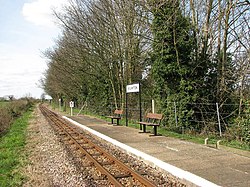Brampton | |
|---|---|
| Station on heritage railway | |
 | |
| General information | |
| Location | Brampton, Norfolk, Broadland, Norfolk England |
| Coordinates | 52°46′02″N1°17′27″E / 52.76709°N 1.29076°E |
| Grid reference | TG221238 |
| Platforms | 1 |
| History | |
| Original company | Bure Valley Railway |
| Key dates | |
| 1990 | Opened |
Brampton railway station serves the village of Brampton in Norfolk and is operated by the Bure Valley Railway, a narrow gauge heritage railway operation. [1] [2]